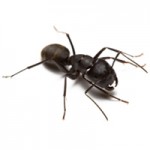
Springtime invigorates us all: the warmer weather compels us to venture outdoors; the increasing daylight awakens certain mammals from their seasonally-appropriate nap; and, the changing temperatures rouse carpenter ants to another season of unabashed foraging and nest expansion, which, unfortunately, is usually accomplished at the expense of our homes.
Carpenter Ants Need a Protein-rich Diet
Carpenter ants ravenously search for protein-rich foods when they awaken in spring, which nourishes the colony and enables a productive year of expansion. Although insects provide a good source of this required protein, the average home offers an inviting array of tasty, protein-rich morsels, such as:
- crumbs from dry pet food
- food residue beneath dishwashers
- accumulation of food within cabinetry
- a dirty stove vent filter
Main Nests and Satellite Nests
Carpenter ants are the only species of ant that will establish an adjunct (satellite) nest in an area which is unlike the environment of the main nest. The main nest can be found in an area that is naturally moist with a high level of humidity, while satellite nests will be established in comparatively drier locations (inside or out), with a lower relative humidity.
Outside, main nests are commonly found in or around:
- tree trunk
- a pile of wood
- a large accumulation of leaf litter
Inside, main nests are often spotted in or around:
- a door threshold
- a window sill
- an area adjacent to the roof that has begun to leak
Signs of Carpenter Ants: Sawdust and “Swarmers”
Nest construction for the carpenter ant is a process where the ant removes a piece of wood with its mandibles, and deposits this grain in a common repository. Unlike termites, carpenter ants are unable to digest wood, so the end-result, when lots of ants are conducting the same, repetitive task, is an accumulation of sawdust in an unexpected area, with a seemingly unknown point of origin.
Another irrefutable sign of carpenter ants is the unexpected emergence of many many-winged ants or “swarmers” from the main nest (from an area of your home that showed no previous signs of water retention), usually in the Spring. See our article “Flying Termites vs. Flying Ants” to learn how to distinguish between carpenter and and termite swarmers
Carpenter ant control can be challenging
It’s difficult to eliminate this common household pest, so early detection is critical and it’s important to work with a trained professional who employs an integrated pest management approach.
Modern offers a HomeCare Green Program that protects your home from 60 pests and the diseases they carry, including carpenter ants. For more information about carpenter ants, visit our website or call us at 1-800-323-378.
